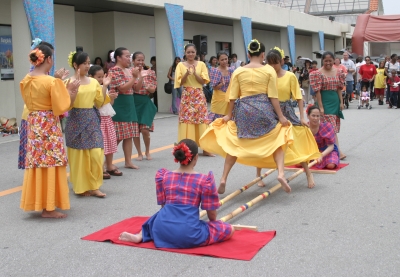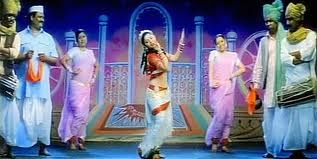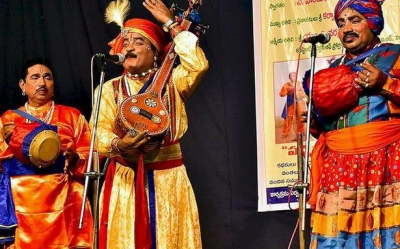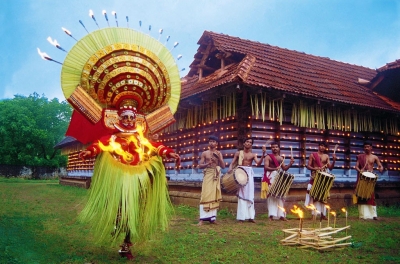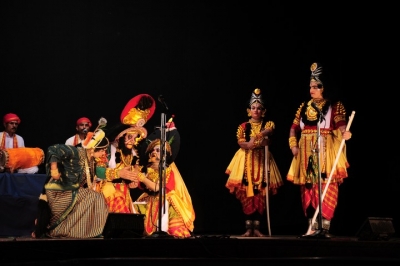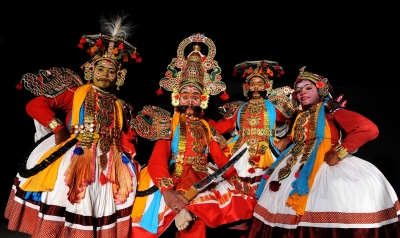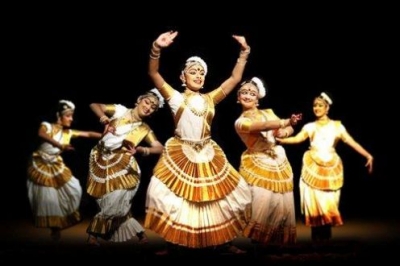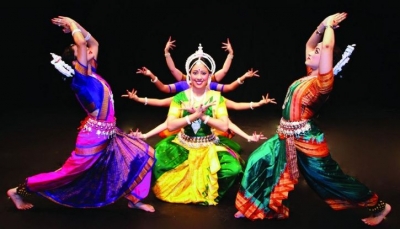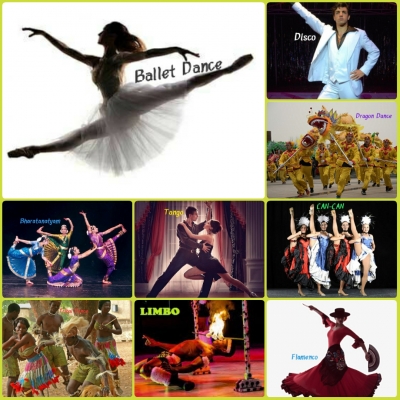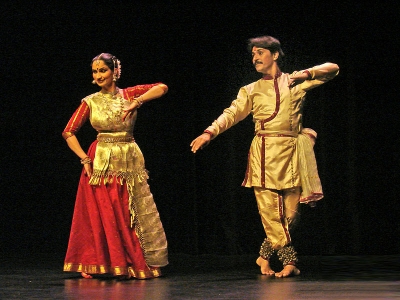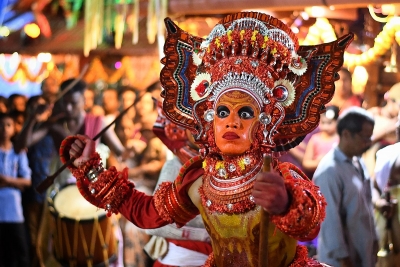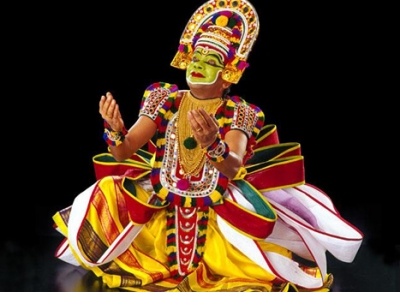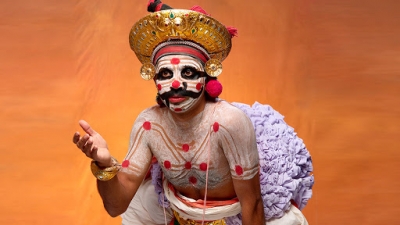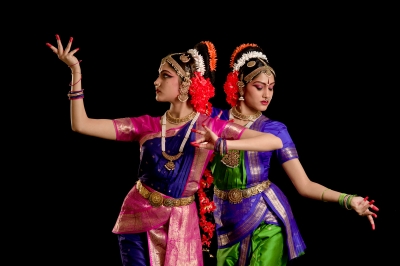
Kuchipudi, the classical dance style of Andhra Pradesh, is accepted as a solo dance but evolved from the dance-drama tradition of Bhagaveta Mela Natakam. Stories from Hindu mythology, particularly Vaishnava Sampradaya (cult of Lord Vishnu), are interpreted through the medium of stylized and rhythmic movements, typical hasta mudras (hand gestures) and expressional dancing. Kuchipudi lays equal emphasis to elegance and vibrant movements and is performed by both men and women.
Evolution and history
The word Kuchipudi comes from the village Kuchelapuram in Krishna district of Andhra Pradesh. The Sanskrit word Kusilava-puram refers to the village of actors, travelling bards or dancers. The authoritative text of dance and dramaturgy, written by Bharata Muni, known as Natya Sastra with 6,000 verses in 36 chapters, studied version, evolved during 500 BCE to 500 CE, that mentions the graceful movements known as Kaishiki Vritti. Pre-2nd century text calls one raga (musical melody) as Andhri (Andhra), related to Gandhari Arsabhi. The 1st milllenium Sanskrit text by Bruna Nettle credits its origin to 3rd century.
The copper inscriptions, from 10th to 15th century of Machupalli kaifat refers to Kuchipudi dance. According to Manohar Varadpande, Kuchipudi emerged in the late 13th century during the reign of the Ganga rulers of Kalinga; however, the dancers enjoyed royal patronage during the reign of King Krishnadevaraya in the Vijayanagara empire.
In 1678, the last Shia Muslim Sultan of Golkonda, Abul Hasan Qutub Shah, gifted the Kuchipudi village to the dancers, as he was impressed with their brilliant performance; however, during the reign of Aurangzeb, he was completely against arts and artistes and destroyed the musical instruments, too. The British, too, did not approve of classical dancers and performing art forms suffered a setback.
Pioneer mentors and technique
The foremost pioneers were Vedantam Lakshminarayana Sastri (1886-1956), Vempatti Venkataramaya Sastri and Chinta Ventaramayya Sastri. Prior to the Bhagavata nataka tradition, dancers interpreted stories related to Shaivism and were known as Brahmana Melas. According to the tradition, Natttuva Melas pertained to the invocatory Puja dance and the Kalika dance in the Kalyana mandapa, the Natya Mela pertained to ritual dances, Kalika dance for intellectuals and Bhagavatam for commoners.
Teertha Narayana Yati, who wrote the Krishna Leela Tarangani, was a sanyasin (sage) of the Advaita Vedanta and his disciple Siddhendra Yogi founded the systematised version in the 17th century. He also induced young Brahmin boys to take up Kuchipudi dance as he felt that if females danced, the purity of the dance will be affected.
Vempatti Chinna Satyam further refurbished the Kuchipudi dance and placed it on the international map. The technique is similar to Bharata Natyam but unlike Bharata Natyam, Kuchipudi dancers are quite light footed with spring-like and bouncing movements that differs in the style of presentation.
Performance and music
Bhama Kalapam, an extract from Krishna Leela Tarangani, forms the mainstay of the Kuchipudi repertoire, besides Golla Kalapam of Ramiah Sastri which is an ethical satire between the Gopis and the Brahmins. Kritis of Tyagaraja and Padams of Kshtreyya, etc., are also part of the performance.
American Esther Sharman, renamed as Ragini Devi, whose daughter Indrani Bajpai or Indrani Rehman, and Yamini Krishnamurti, are among the foremost exponents. Leading exponents, Raja Radha and Kausalya Reddy, Swapna Sundari, Sobha Naidu, Vyjayanthi Kashi, Jayarama and Vanashree Rao, Narasimha Chari, Anuradha J., and young brilliant dancers including Yamini and Bhavana Reddy, Prateeksha Kashi, Avijit Das, Alekhya Punjala, etc.
Traditionally a Kuchipudi performance commences with invocations to Lord Ganesha, Lord Nataraja and Goddess Parvati, while paying salutations; the dancer also receives blessings for the successful performance without any hindrance whatsoever. After the Jatiswaram is performed which is a fine combination of music, melody and rhythm, interwoven with jatis, the display of rhythmic complex patterns of varied movements, followed with the Sabdam, Padam, Varnam, another Padam or Bhajan and finally the Thillana or the Tarangam which is the dance on the rim of the brass plate.
Performances are solo and dance dramas like Rukmini Kalyanam or Sreenivasa Kalyanam and other dramas pertaining to Lord Shiva, Rama, Kartikeya and Ganapati are also enacted and presented.
It was believed that if you have to please Lord Krishna, you have to don female attire at least once. During the 19th century, females were barred from performing Kuchipudi. Hence the tradition developed wherein male dancers attired like females, interpreting both masculine and feminine characters.
One of the mainstays of the Kuchipudi repertoire is the interpretation of Bhama Kalapam or the story of Satyabhama. Satyabhama, like other women, was in love with Krishna; she was a royal and beautiful lady but arrogant. Krishna wanted to teach her a lesson, hence asked her as to who was more beautiful, Satyabhama or Krishna. As expected, Satyabhama claimed that she was the most beautiful woman. Krishna argued with her and angrily drifted away. Satyabhama realised her mistake and asked for forgiveness. Bhama Kalapam is an extract from Krishna Leela Tarangani written by saint composer Narayana Teertha.
It is interesting to narrate here one of the Kuchipudi performances rendered by the renowned and dynamic Yamini Krishnamurti. She was interpreting the number Swami Ra Ra (Please come, My Lord) wherein the dancer as the heroine requests the Lord to come as soon as possible as she is unable to bear the pangs of separation. While interpreting this number with large expressive eyes, a Sardarji went up to the stage. The dancer responded, saying: "I am calling my Swami, My Lord, you are not He!"
Credit : Guru Vijay Shanker (The Teenager Today)
Picture Credit : Google
